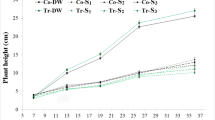Abstract
Dispersal of root pathogens is a major concern in closed hydroponic cultures. To limit dispersal, ultraviolet (UV) disinfection technology has been used to remove pathogens but its effect on non-target bacterial populations is largely unknown. In this study, the circulating solution was disinfected with various UV doses (i.e., 19, 38, 59, 88 mJ cm−2) before recirculation. At the beginning of the experiment, the hydroponic solution was inoculated with Pythium aphanidermatum at 6.7±1.5 CFU mL−1. Four months later the population density of P. aphanidermatum reached 1030 CFU mL−1 in the control and 1028, 970, 610, and 521 CFU mL−1 in the solutions treated by the above UV doses. In all UV-treated solutions, significant (P<0.05) reduction of both Pythium and bacterial populations was noted. For the former, its reduction did not result in decrease of Pythium root rot nor increase of tomato fruit yield. For the latter, its reduction showed a concomitant decrease of the populations in the rhizosphere. The bacterial populations in the rhizosphere were 6.77×109 CFU mg−1 fresh roots at the beginning of the experiment and were 7.89×108, 9.93×107, 7.33×107, and 3.51×107 CFU mg−1 fresh roots at the end of the experiment in the control, UV38, UV59, and UV88 treatments, respectively. The bacterial density also decreased with time in the control (UV0) although at a low rate. The results suggest that the attempt to control Pythium root rot by UV irradiation of recirculating solutions to remove P. aphanidermatum also affects the non-target bacterial populations in the rhizosphere. The interaction between the target pathogen and non-target bacterial flora in UV-treated hydroponics needs further investigation.
Similar content being viewed by others
References
Berger F, Li H, White D, Frazer R and Leifert C (1996) Effect of pathogen inoculum, antagonist density, and plant species on biological control of Phytophthora and Pythium damping-off by Bacillus subtilis Cot1 in high-humidity fogging glasshouses. Phytopathology 86: 428–433
Berkelmann B, Wohanka W and Wolf GA (1994) Characterization of the bacterial flora in recirculating nutrient solutions of a hydroponic system with rockwool. Acta Hort 361: 372–381
Burr TJ and Stanghellini ME (1973) Propagule nature and density of Pythium aphanidermatum in field soil. Phytopathology 63: 1499–1501
Buyanovsky G, Gale J and Degani N (1981) Ultraviolet radiation for the inactivation of microorganisms in hydroponics. Plant and Soil 60: 131–136
Chen C, Belanger RR, Benhamou N and Paulitz TC (1998) Induced systemic resistance (ISR) by Pseudomonas spp. impairs pre-and post-infection development of Pythium aphanidermatum on cucumber roots. Eur J Plant Pathol 104: 877–886
Ewart JM and Chrimes JR (1980) Effects of chlorine and ultraviolet light in disease control in NFT. Acta Hort 98: 317–323
Fukui R, Campbell GS and Cook RJ (1994) Factors influencing the incidence of embryo infection by Pythium spp. during germination of wheat seeds in soils. Phytopathology 84: 695–702
Jarvis WR (1996) Managing Diseases in Greenhouse Crops. American Phytopathological Society Press, St Paul, MN
Jenkins Jr SF and Averre CW (1983) Root diseases of vegetables in hydroponic culture systems in North Carolina greenhouses. Plant Dis 67: 968–970
Loper JE and Buyer JS (1991) Siderophores in microbial interactions on plant surfaces. Mol Plant-Microbe Interact 4: 5–13
Menzies JG and Bélanger RR (1996) Recent advances in cultural management of diseases of greenhouse crops. Can J Plant Pathol 18: 186–193
Menzies JG, Ehret DL and Stan S (1996) Effect of inoculum density of Pythium aphanidermatum on the growth and yield of cucumber plants grown in recirculating nutrient film culture. Can J Plant Pathol 18: 50–54
Paulitz TC (1997) Biological control of root pathogens in soilless and hydroponic systems. HortScience 32: 193–196
Paulitz TC, Zhou T and Rankin L (1992) Selection of rhizosphere bacteria for biological control of Pythium aphanidermatum on hydroponically grown cucumber. Biol Control 2: 226–237
Paludan N (1985) Spread of viruses by recirculated nutrient solutions in soilless cultures. Tidsskr Planteavl 89: 467–474
Rankin L and Paulitz TC (1994) Evaluation of rhizosphere bacteria for biological control of Pythium root rot of greenhouse cucumbers in hydroponic culture. Plant Dis 78: 447–451
Runia WTh (1994) Elimination of root-infecting pathogens in recirculation water from closed cultivation systems by ultraviolet radiation. Acta Hort 361: 361–371
Runia WTh (1995) A review of possibilities for disinfection of recirculation water from soilless cultures. Acta Hort 382: 221–229
Stanghellini ME and Miller RM (1997) Biosurfactants-their identity and potential efficacy in the biological control of zoosporic plant pathogens. Plant Dis 81: 4–11
Stanghellini ME and Rasmussen SL (1994) Hydroponics-a solution for zoosporic pathogens. Plant Dis 78: 1129–1138
Stanghellini ME, Stowell LJ and Bates ML (1984) Control of root rot of spinach caused by Pythium aphanidermatum in a recirculating hydroponic system by ultraviolet irradiation. Plant Dis 68: 1075–1076
Waechter-Kristensen B, Gertsson UE and Sundin P (1994) Prospects for microbial stabilization in the hydroponic culture of tomato using circulating nutrient solution. Acta Hort 361: 382–387
Zhang W and Tu JC (1999) Response of Pythium aphanidermatum zoospores to ultraviolet radiation in a laboratory collimated beam assay. Microbios 97: 19–28
Author information
Authors and Affiliations
Rights and permissions
About this article
Cite this article
Zhang, W., Tu, J. Effect of Ultraviolet Disinfection of Hydroponic Solutions on Pythium Root Rot and Non-target Bacteria. European Journal of Plant Pathology 106, 415–421 (2000). https://doi.org/10.1023/A:1008798710325
Issue Date:
DOI: https://doi.org/10.1023/A:1008798710325




